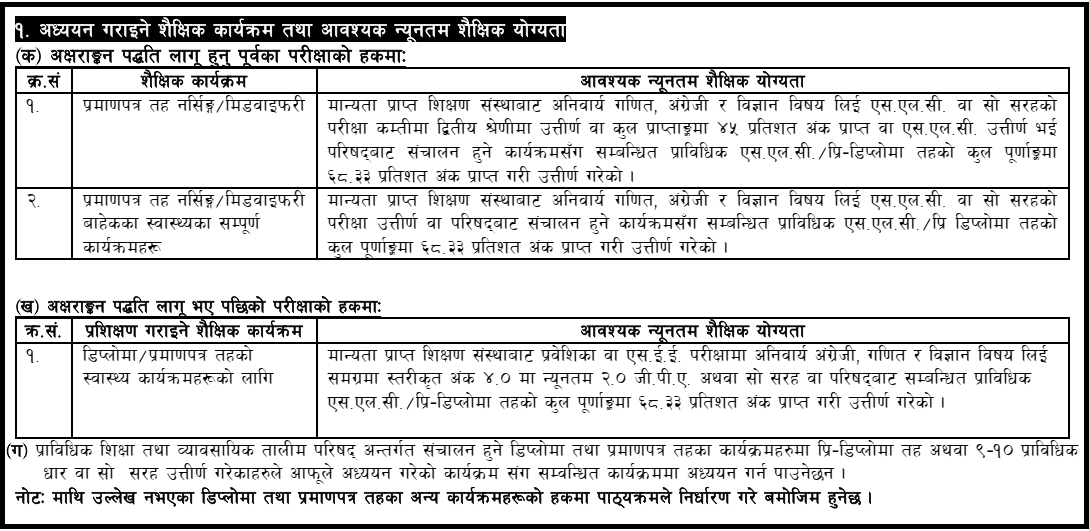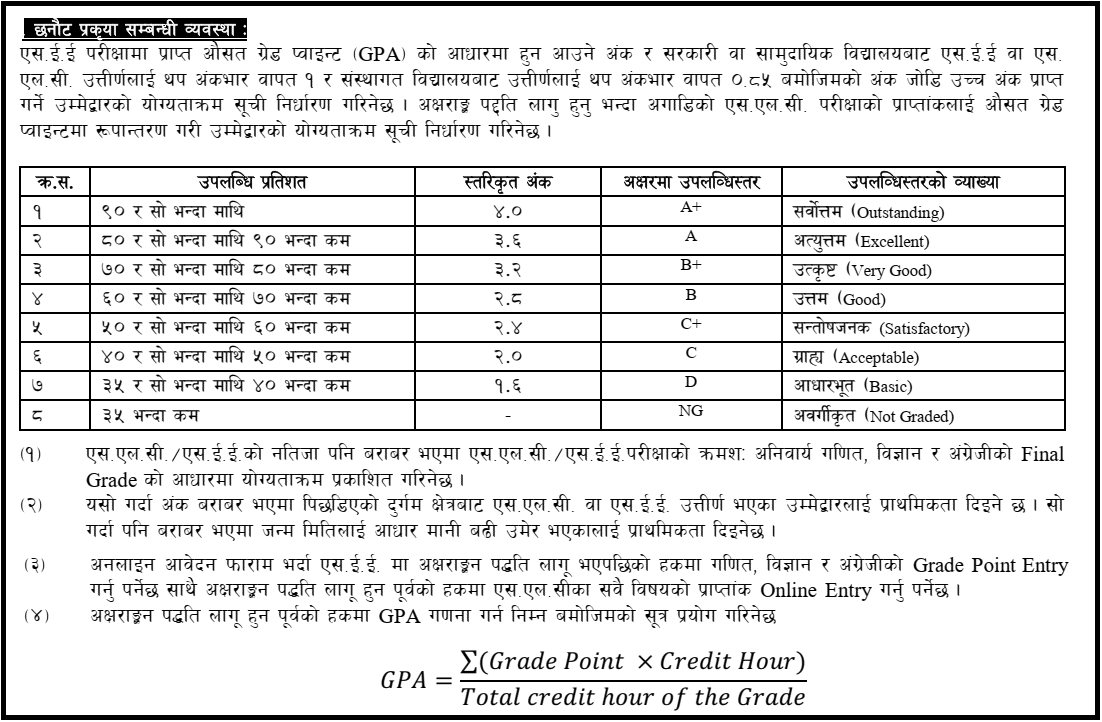
Diploma in Ophthalmic Science: List of All Colleges in Nepal
The Diploma in Ophthalmic Science program, under the Council for Technical Education and Vocational Training (CTEVT), is a three-year program designed to prepare skilled ophthalmic health professionals.
Graduates of this program are trained to provide primary eye care, assist ophthalmologists in diagnosis and treatment, perform basic eye procedures, and support community-based eye health services. They play a crucial role in reducing preventable blindness and promoting eye health in Nepal.
Each affiliated institution admits 40 students per intake, with scholarships reserved for deserving candidates.
Program Details
-
Program Duration: 3 Years
-
Seats per Institution: 40 seats
-
Scholarship Seats: 10% of seats, or a maximum of 4 seats per institution, are reserved under the scholarship quota
Eligibility Criteria

(a) For examinations conducted before the implementation of the letter grading system:
-
Passed SLC or equivalent examination from a recognized educational institution with compulsory Mathematics, English, and Science.
-
Alternatively, passed a related Technical SLC/Pre-Diploma program conducted by CTEVT with at least 68.33% of the total marks.
(b) For examinations conducted after the implementation of the letter grading system:
-
Passed SEE or equivalent examination with compulsory English, Mathematics, and Science, securing a minimum GPA of 2.0 out of 4.0 in aggregate.
-
Alternatively, passed a related Technical SLC/Pre-Diploma program conducted by CTEVT with at least 68.33% of the total marks.
(c) Additional Provision:
-
Students who have completed Pre-Diploma Level or Grade 9–10 Technical Stream or equivalent under CTEVT cannot enroll in a Diploma or Certificate Level program in the same field they have already studied.
Required Documents
Applicants must submit the following documents with their application:
-
Two recent passport-size photographs (35mm x 45mm) with the candidate’s name and chosen program written on the back
-
Copy of SEE/SLC or Technical SLC (Pre-Diploma)/Equivalent mark sheet and transcripts
-
Copy of citizenship certificate or another valid ID issued by the Government of Nepal
-
Recommendation letter from the concerned authority for the full-fee reserved quota (if applicable)
-
Proof of entrance examination fee payment as per the “Entrance Examination Conduct, Scholarship Distribution, and Admission Guidelines 2081”
Selection Method for Admission

The merit list of candidates is determined based on the average Grade Point (GPA) obtained in the SEE examination.
-
Candidates from government or community schools receive a weightage of 1.0.
-
Candidates from institutional/private schools receive a weightage of 0.85.
-
For SLC graduates under the pre-grading system, marks are converted into equivalent GPA.
GPA Conversion and Achievement Levels
| Achievement Percentage | Grade Point | Letter Grade | Description |
|---|---|---|---|
| 90 and above | 4.0 | A+ | Outstanding |
| 80 – below 90 | 3.6 | A | Excellent |
| 70 – below 80 | 3.2 | B+ | Very Good |
| 60 – below 70 | 2.8 | B | Good |
| 50 – below 60 | 2.4 | C+ | Satisfactory |
| 40 – below 50 | 2.0 | C | Acceptable |
| 35 – below 40 | 1.6 | D | Basic |
| Below 35 | – | NG | Not Graded |
Additional Provisions
-
If GPA is the same, priority is given based on final grades in compulsory Mathematics, Science, and English (in that order).
-
If still tied, priority is given to candidates from disadvantaged or remote areas.
-
If still tied, the older candidate is given priority based on date of birth.
-
For SEE candidates, grades of Mathematics, Science, and English must be entered in the application.
-
For SLC candidates (before grading), marks for all subjects must be entered.
-
GPA calculation formula:
GPA = Σ (Grade Point × Credit Hour) ÷ Total Credit Hour
Fees
-
Total Fees: As per the guidelines of CTEVT
-
Application Fee: As per the guidelines of CTEVT
Course Accreditation
The Diploma in Ophthalmic Science program is accredited by the Nepal Health Professional Council (NHPC). After completing the program, graduates must pass the licensing examination before starting professional practice.
Career Opportunities
Graduates of the program can work in diverse healthcare and eye care services, such as:
-
Eye hospitals and ophthalmic departments in general hospitals
-
Community eye care centers and vision screening programs
-
Diagnostic and treatment units in clinics
-
NGOs and INGOs working in blindness prevention and eye health
-
Government health services focused on ophthalmology
-
Research and academic institutions in ophthalmic science
Future Scope
The demand for trained ophthalmic professionals is growing in Nepal and abroad. Graduates may choose to:
-
Pursue higher education in Ophthalmic Science, Public Health, or related health sciences
-
Specialize in areas such as refraction, orthoptics, pediatric ophthalmology, or ocular surgery assistance
-
Take on supervisory and leadership roles in eye hospitals or community eye programs
-
Contribute to blindness prevention and eye health research
-
Work internationally in hospitals, eye centers, or global health organizations
Why Choose the Diploma in Ophthalmic Science Program?
Balanced Curriculum
The program integrates classroom teaching with hands-on training in eye care and diagnostic practices.
National Recognition
Accredited by NHPC, the program ensures graduates are qualified for licensing and professional practice.
Scholarship Support
Reserved scholarship seats allow students from different backgrounds to access the program with financial support.
High Demand
Ophthalmic professionals are increasingly needed in both public and private health systems.
Pathway to Higher Education
Graduates can progress into Bachelor’s and Master’s level studies in Ophthalmology, Optometry, or other health sciences.
Skill Development
Students gain practical skills in patient care, vision testing, and clinical support for eye treatments.
Community Contribution
Graduates directly support community health by preventing blindness and improving eye care access.
Global Opportunities
Nepali ophthalmic science graduates are recognized internationally, opening opportunities in eye hospitals and global eye health projects.
Affordable Option
The program fee structure under CTEVT makes it more accessible compared to many other health-related courses.
List of All Colleges Offering Diploma in Ophthalmic Science Program in Nepal
The Council for Technical Education and Vocational Training (CTEVT) has approved the following institutions to operate the Diploma in Ophthalmic Science program for the academic session 2082/83. The province-wise list of affiliated institutions is as follows:
Koshi Province (2 Institutes)
-
Life Line Hospital, Jhapa
-
Manasrovar Institute of Science and Technology, Damak
Madhesh Province (2 Institutes)
-
Sagarmatha Chaudhary Eye Hospital, School of Medical Science, Lahan
-
Birendra Institute of Medical and Dental Technology, Janakpur
Lumbini Province (4 Institutes)
-
Kailpal Hospital and College, Nepalgunj
-
Nepal Netra Jyoti Sangh, Fatehbal Eye Hospital, College of Ophthalmic Health Science, Nepalgunj, Banke
-
Rapti Eye Hospital, Netrajyoti Technical College, Tulsipur, Dang
-
Nepal Netra Jyoti Sangh (Lumbini Eye Institute of Ophthalmic Science, Bhairahawa, Rupandehi)
Sudurpaschim Province (1 Institute)
-
Mahakali Polytechnic Institute, Kanchanpur
Also Read
-
Certificate in Dental Science (Dental Hygiene) Colleges in Nepal
-
PCL in Ayurveda and General Medicine (AHA) Colleges in Nepal
-
Certificate in Medical Lab Technology (CMLT) Colleges in Nepal


